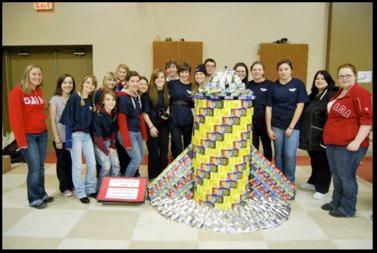
2 minute read
Number of individuals who stayed in a shelter bed
Community highlights
Moncton mental health project making a difference
• Greater Moncton was one offive sites in Canada chosen to participate in a research demonstration project on chronic homelessness and mental illness. Based on a “housing first” strategy, the objective is to place 100 participants in their own apartments, with a support team built around them. By the end of2009, 31 people had been accepted into the program, ofwhom 16 had been placed in an apartment. Another 25 people with mental health challenges in rural areas around Moncton will be helped to find and remain in housing. • 737 individuals used shelter beds at the House ofNazareth for a total of4,550 nights. • 200 individuals slept on mats on the floor at the Harvest House Outreach Centre for a total of4,759 nights. • 4,355 people in Greater Moncton were living on provincial Social Assistance at the end of2009, up from 4,170 a year earlier. Some 640 people were on the waiting list for NB Housing. • It Tannery opened i C n ourt Co-operativ early 2010 with e II 50 was subs constructed throug idized units for non hout -elde 20 rly 09. M lo M oncton Youth Residences Inc. recated its Youth Transition House to acBeath Street in Moncton, and added singles. two more units, for a total of eight beds (four male, four female).
Saint John hosts youth events
• A newtreatment clinic for people addicted to drugs such as heroin and Dilaudid opened in August. The uptown methadone clinic was launched to help deal with a waiting list of180 people at the Ridgewood Addictions Services Treatment Centre.




• Outflow, an outreach organization for homeless people, opened a drop-in centre in the uptown area. It serves a hot meal each day from Monday to Friday, and organizes a Sunday supper at an uptown church. youth and addressed their concerns. On November 3, the Business Community AntiPoverty Initiative (BCAPI) hosted a community forum called, “Pathways to Education and Employment for At-Risk Youth.” The group identified transition housing for homeless youth as a top priority. On November 22-23, youth from area schools took part in a National Housing Day
Youth at area high schools built sculptures out oftin cans as part ofthe Tin Cup Challenge. The 4,000 cans used to make the various sculptures were donated to area food banks. • Saint John hosted events that both engaged
Event called HELP (Housing Education Learning Party). They learned about becoming more active in their communities through listening to guest speakers, and volunteering with organizations that work with homeless people. They also collected more than 4,000 cans offood for area food banks.
For more information on the contents of this report, please contact:
Community Homelessness Network Inc. (Bathurst) Greater Moncton Homelessness Steering Committee Pauline Armstrong at 506-545-0805 or Sue Calhoun at 506-877-2343 or parmstrong@nb.aibn.com scalhoun@nbnet.nb.ca The Fredericton Community Action Group on Homelessness Fiona Williams at 506-444-81 99 or cmhafo@nb.aibn.com Greater Saint John Homelessness Steering Committee Mark Leger at 506-636-8541 or mark@sjhdc.ca
2ND REPORTCARDONHOMELESSNESS INNEWBRUNSWICK, 2010 10






